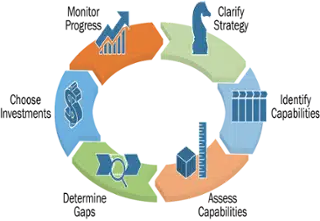Here at Accelare, we know how to help companies improve their productivity at the corporate level through digital transformation. But any organization’s productivity is based on its employees’ individual productivity levels. And, with working remotely becoming widespread, we imagine it’s a question you’d like answered. In this article, we will answer the following questions:
- What is an Agile Approach?
- How can I apply the Agile Approach to my personal life?
- Where can I find resources to help me learn and apply Agile personally and professionally?
What is the Agile Approach?
The Agile approach was born through a team of experts “uncovering better ways of developing software by doing and helping others do it.” Agile is a proven methodology designed to deliver business value, favoring progress over perfection. It emphasizes communication, continuous improvement, collaboration, and effective response to change. “Scrum” is an Agile framework that produces outcomes in short increments (typically a couple of weeks).
Here’s a visual and brief overview of the Scrum flow:
- The Product Backlog, maintained by the Product Owner, contains work elements (stories) that contribute to a product that delivers business value. Stories contain information about the business problem, role(s) involved, approach, success criteria, and effort required to complete.
- The Team is led by a Scrum Master and works to plan and execute the stories for short cycles of work, or Sprints.
- There is a brief update meeting each day, or Daily Scrum, during the Sprint for the team members to report on what they’ve done since the last Scrum, what they are working on, and identify any help needed.
- At the end of the Sprint, the team shares and celebrates their achievements during a demonstration session. They also spend time discussing successes and areas of improvement during the Sprint Review & Retrospective, which will be incorporated into future Sprints.
- This flow repeats to build on progress and continuously deliver value.
71% of companies have adopted an Agile framework. 98% of those companies have been helped and seen a positive impact (GoRemotely). Since this has proven to be such an effective methodology from a professional and corporate standpoint, why not implement a similar approach in our everyday lives?
How You Can Apply Agile to Your Personal Life?
The Agile approach has proven to be highly effective in driving business outcomes and team productivity. The tenets of Agile can be translated to our personal lives to achieve daily, weekly, or even monthly goals. The beauty is in its simplicity, ability to effectively manage change in priorities, and focus on progress, not perfection! To help explain, let’s revisit the Scrum visual: The Backlog is your (the Owner’s) complete inventory of Tasks (your Stories) to complete. Make a list to tackle this! Weed out unnecessary work, juggle tasks simultaneously and maximize the outcomes of your to-do list. Ask yourself:
- Why is this important?
- Who needs to be involved (is it just you or someone else)?
- How will you approach it? What are the steps?
- How much time/effort will it take?
- What does success look like? How will you know the work is complete?
Sprint Planning is focused time you set aside to prioritize the tasks you want to complete during your personal Sprint which might be a week, or if you’re ambitious, a single day! The outstanding tasks you have identified become your Sprint Backlog.
REMEMBER! Agile emphasizes incremental progress, building on success. Be mindful with your goal setting; make sure your Sprint Backlog is achievable. If a task/story seems too big to fit in a Sprint, consider breaking it into multiple tasks with smaller, more focused effort with realistic goals.
Now that you’ve got your ‘to-do’ list, find a Scrum Master who will keep you on track. This could be a coach, accountability partner, or yourself (wearing a ‘different hat’ of course) to help keep you on track! Take five minutes each day and hold the time as sacred to run your personal Scrum.
3 Questions for Your 5-Minute Scrum
- What have you done?
- What are you working on?
- What obstacle(s), if any, are you facing? How can you remove the obstacle(s)?
At the end of your Sprint, take time for the Review & Retrospective. What tasks did you complete? What went well? What could have been improved? How can you apply that lesson in the future? It’s critical to use this time with a dual-purpose in mind: recognize your achievements and reflect on how you can improve!
Are you ready to turn this theory to practice? Our team of experts will help you fundamentally change the way you execute tasks and stories – professionally and personally. Increase your productivity and velocity through efficient decision-making and clear accountability. Our Agile approach teaches a new way of working. We help you create sustainable and flexible processes to effectively implement Agile across your entire organization or drill down to the individual/team level.
How fit is your enterprise? Unsure? Accelare’ s enterprise fitness assessment may be what your organization needs. Increase your agility by assessing your current state and identifying areas for improvement!
Execute your work and projects effectively with an agile approach! Set up a time with our experts to discuss transformative, iterative and incremental outcomes that enable your teams to adapt and re-prioritize their work. Equip your teams with the knowledge to self-direct and self-manage to better estimate, commit, and deliver on timelines.
Co-Authored by Jennifer Byrnes & Hugh Flood
Jennifer Byrnes is a Principal Consultant with Accelare and specializes in Organizational Change Leadership and Leadership Coaching. To learn more about how we can support you through this uncharted landscape of remote work, reach out to Jennifer at jennifer.byrnes@accelare.com.
Hugh Flood draws on over 20 years of experience leading implementation programs, designing business architectures, and re-engineering processes for clients across a diverse set of industries including Healthcare, Financial Services, Pharmaceuticals, Utilities, Chemicals, and Manufacturing.










